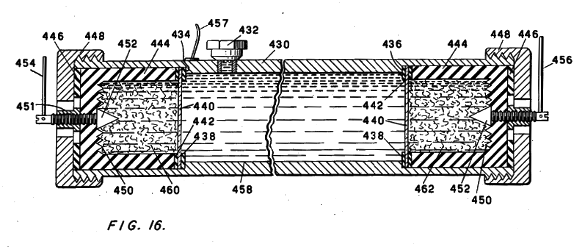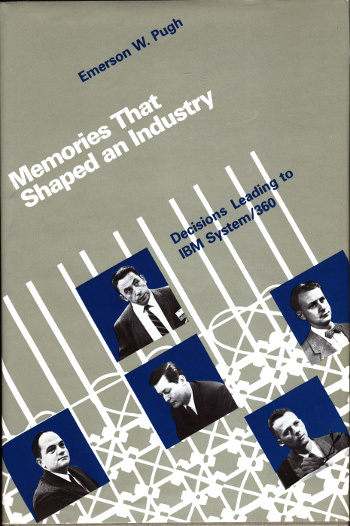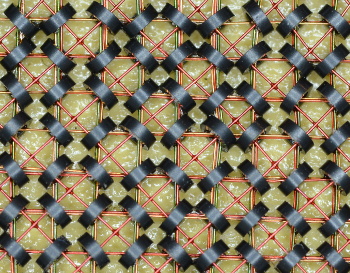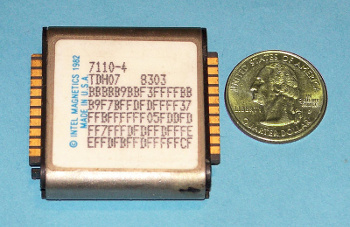Magnetic Memory
January 19, 2017
Microprocessors, and their predecessor
central processing units (CPUs), have gotten the
lion's share of attention in
computer hardware.
Faster clock rates and
novel architectures have always generated a lot of
media coverage, but all that
finesse would be useless with
computer memory.
Various
technologies were used to implement
data memory in
early computers. Data were stored as patches of
electric charge in
cathode ray tubes (the
Williams tube), and
acoustic waves in a vat of
mercury (a
delay line memory, see figure). As can be imagined, the
volume density of
data storage for such devices was very small, and there was a long
access time to a particular data
bit.

A mercury delay line computer memory system, fig. 16 of US Patent No. 2,629,827, "Memory system," by John Presper Eckert, Jr., and John W. Mauchly, February 24, 1953. Elements 440 are quartz wafers that act as transmitters and receivers of the acoustic wave. Mercury was used as the wave medium, since its high density (13.5 g/cc at room temperature) results in a relatively low speed of sound (1,451.4 meters per second). This patent disclosed, also, delay lines implemented by electric charging, or exciting phosphors, at the circumference of a rotating disk. (via Google Patents.[1]
Magnetic storage of
information was known long before the first
electronic computers.
Valdemar Poulsen, a prolific
Danish electrical engineer,
invented magnetic wire recording in 1898. It was just a short conceptual leap from wire recording to the
drum memory in which data were written onto the magnetic surface of a drum. An array of many
read/write heads could be placed at the
circumference of the drum to increase the volume density of information. The density of 0.5
megabits per drum, or less, is small by today's standards. The
BSD operating system still incorporates a
/dev/drum memory device.
Since the magnetic drum is a
sequential access memory device, the speed of data access is slow. On average, you need to wait a half rotation of the drum to get a particular data bit. That's why engineers were excited around 1950 when they noted the
magnetic square-loop response and rapid switching speed of some
ferrite materials, such as (Fe,Mg,Mn)
3O
4.[2]
It's easy to
magnetize some
materials, notably
iron, by passing an
electric current through a surrounding
solenoid coil, generating a magnetizing field. The problem is that most such materials won't retain their
magnetic moment when the current is removed, and the process is typically very slow. The ferrite materials have a
B-H loop, the graph of their
magnetization as a
function of
applied magnetic field, that's nearly a
square. That means that application of reversing currents will switch the ferrite cleanly and quickly from one magnetic state to another - a perfect feature for a memory element.

The dust jacket of Emerson W. Pugh's "Memories that Shaped an Industry: Decisions Leading to IBM System/360," a book that recalls the history of ferrite core memory.[3]
The book features some of the pioneers of this technology.
Photographs, by row, left to right, from top, Erich Bloch, John W. Gibson, Bill Rhodes, Mike Haynes, and Jay Forrester
(Scan of my copy.)
This period of computer development in the
1950s was long before the
Planar processing that allowed considerable
circuit complexity at minimal
cost. The bits of a
core memory were individual ferrite
toroids that were addressed by current-carrying
wires running through them, and these were laboriously assembled by hand into memory arrays (see photo). For those who think that
off-shoring of labor is a recent development, most of this hand assembly was done by low paid workers in
East Asia.[3]

A ferrite core memory array.
The individual cores are 0.090" diameter, 0.030" thick, with a 0.060" diameter hole.[3]
(Portion of a Wikimedia Commons photo by Jud McCranie.)
Initially, an entire day's hand assembly was required to create a 64x64 bit array, but this was reduced to about 12 minutes with
automated tooling.[3] The cost per bit likewise decreased from $1.00 to $0.01. The first core memories had an access time of about 6 μs, and this was improved to 0.6 μs (600 ns) within a
decade. This later memory access speed is roughly equivalent to the earliest
personal computers, such as the
Apple II computer. Switching at such high rates was difficult with the electronics of the time, since nearly half an
ampere's current was required in the two bit address lines (see figure).

Coincident-current selection of a ferrite core memory element.
Selection is understood by application of the right-hand rule to the current in a quarter turn of wire.
(Drawn by the author using Inkscape.)
The pace of technology is unrelenting. Soon,
semiconductor memory technologies offered better performance at a better price, and ferrite core memories were essentially obsolete within fifteen years of their introduction. Another magnetic memory technology,
bubble memory, which made use of semiconductor planar-processing techniques, made a brief appearance after ferrite core; but those, too, were obsolete by the
late-1980s.

A magnetic bubble memory module.
(Photo by the author, via Wikimedia Commons.)
Erich Bloch, one of the principals of core memory development, and the top image on the
dust jacket of Pugh's book, shown above, outlived core memory by many decades. Bloch died November 25, 2016, at age 91.[4] Bloch, born of
Jewish parents in
Sulzburg, Germany, on January 9, 1925, came to the
United States after being
orphaned during the
Holocaust.[4]
Bloch received his
B.S. degree in
electrical engineering from the
University of Buffalo, and he went to work for prominent
New York manufacturer,
IBM. At IBM, Bloch was on the development team for the
IBM 7030, an early
transistorized mainframe computer that executed a
half million instructions per second. The IBM 7030 was followed by the
System/360, the
development of which IBM invested $5 billion, a tremendous amount of money at the time.[4] The System/360 was a
commercial succes, and I ran my
computer programs on one during my
graduate school days. Bloch
retired from IBM in 1984, and he was
director of the
National Science Foundation from 1984 to 1990 under
Ronald Reagan.[4]
References:
- John Presper Eckert, Jr., and John W Mauchly, "Memory system," US Patent No. 2,629,827, February 24, 1953.
- Ernst Albers-Schonberg, "Process of making molded ceramic ferromagnetic products," US Patent No. 2,700,023, January 18, 1955.
- Emerson W. Pugh, "Memories that Shaped an Industry: Decisions Leading to IBM System/360," MIT Press (April, 1984, Out of Print).
- Steven Musil, "Erich Bloch, IBM mainframe pioneer, dies at 91," CNET, December 1, 2016.
Permanent Link to this article
Linked Keywords: Microprocessor; central processing unit (CPU); lion's share; computer hardware; megahertz myth; faster clock rate; instruction pipelining; novel architecture; mass media; finesse; computer memory; technology; technologies; data; early computers; electric charge; cathode ray tube; Williams tube; acoustic waves; mercury; delay line memory; volume density; data storage; access time; bit; mercury; delay line computer memory system; John Presper Eckert, Jr.; John W. Mauchly; quartz; wafer; transducer; transmitter; receiver; acoustic wave; density; kilogram per cubic metre; g/cc; room temperature; speed of sound; meters per second; patent; phosphor; circumference; rotation; rotating; Google Patents; magnetic field; information; electronic; Valdemar Poulsen; Denmark; Danish; electrical engineer; invention; invented; magnetic wire recording; drum memory; read/write head; circumference; megabit; Berkeley Software Distribution; BSD operating system; sequential access memory; magnetic hysteresis; magnetic square-loop response; ferrite core; ferrite material; magnetization; magnetize; material; iron; electric current; solenoid coil; magnetic moment; B-H loop; function; applied magnetic field; square; dust jacket; Emerson W. Pugh; history; ferrite core memory; innovation; pioneer; technology; Erich Bloch; Jay Forrester; 1950s; planar processing; electronic circuit; cost; toroid; wire; offshoring; off-shoring of labor; East Asia; Wikimedia Commons; Jud McCranie; automation; automated; machine tool; tooling; decade; personal computer; Apple II computer; ampere; right-hand rule; Inkscape; semiconductor memory; bubble memory; late-1980s; Jewish; parents; Sulzburg, Germany; United States; orphan; orphaned; Holocaust; Bachelor of Science; B.S. degree; electrical engineering; University of Buffalo; New York; manufacturer; IBM; IBM 7030 Stretch; transistor; transistorized; mainframe computer; instructions per second; System/360; development; commercial; computer program; graduate school; retirement; retired; director; National Science Foundation; Ronald Reagan; John Presper Eckert, Jr., and John W Mauchly, "Memory system," US Patent No. 2,629,827, February 24, 1953; Ernst Albers-Schonberg, "Process of making molded ceramic ferromagnetic products," US Patent No. 2,700,023, January 18, 1955.